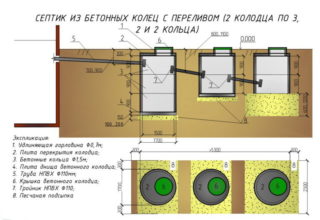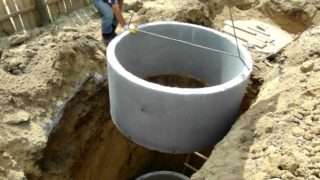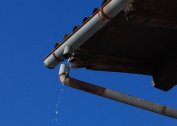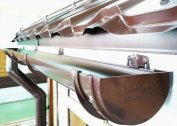An overflow cesspool is suitable for private houses that use appliances that increase comfort: water heaters, washing machines and dishwashers, showers, bathtubs. Only such an option of a non-purchased device is able to cope with the abundance of liquid waste.
Varieties of cesspools
Wastewater treatment plants vary in design and scope. Most often, the following types of pits are equipped on personal plots:
- Absorbing without a bottom. Designs are suitable for areas where the daily volume of effluents does not exceed cubic meters. Their principle of operation is that the wastewater, passing through the drainage layer in the well, is purified, and then absorbed by the soil.
- Sealed chambers for the accumulation of sewage. It is ecologically safe, since drainage waters do not penetrate into the environment - they are pumped out by sewage machines. A variant of such a treatment design is the storage septic tanks - due to the impact of biological products, they need to be cleaned less often.
- Sumps with overflow. This is an even more advanced option. After clarification, the liquid can be used for watering garden plants.
Each of the varieties can be made with your own hands, including a sump with overflow for sewage in a private house.
The principle of construction
Wastewater treatment plants of this type can filter sewage up to 90–95%. The scheme of the overflow two-chamber septic tank-settler is quite simple. Two tanks are combined with each other using plastic pipes.
There may be more capacities, but for a small cottage there are enough pairs. The first acts as a sump and accumulator of water-insoluble heavy particles of dirt. It must necessarily have a hatch for the hose of sewage equipment, since such septic tanks still require pumping out, although less often than just storage ones.
Once in the second chamber, the clarified liquid is re-settled and purified by the bacterial flora, which feeds on organic matter and biowaste.
After cleaning in the second tank, the liquid is sent to the filtration fields or to the infiltrator. In the overflow pipe, it is also possible to install filter screens and grease traps that trap some of the dirt when overflows from one tank to another. On the filtering devices are bacteria that contribute to the decomposition of waste. When using the aerobic type of microorganisms, the design is equipped with ventilation shafts or an aerator.
There is an option even simpler: the treatment device also consists of two containers, while the first is tight, and the second is installed without a bottom. Instead, a mixture of sand and gravel is poured, acting as a filter. Overflowing from the first tank into the second, clarified liquid is subjected to mechanical cleaning, passing through a sand-gravel cushion, and then gets into the ground.
Advantages and imperfections of the overflow pit
The main plus of the sewage system is the lack of frequent cleaning with special equipment. In addition, the settled liquid can be used for household needs: water the plants, fertilize the beds.
Additional advantages of this device:
- The effectiveness of cleansing. Sewer water is subjected to several stages of treatment in the settling and filtration chambers.
- High throughput - 0.2-0.5 cubic meters per hour.
- Almost no odors.
The disadvantages include the complexity of installation.It consists in accurately calculating the angle for connecting the pipe and the location of the containers in relation to each other. Also, construction compared to a conventional pit will come out more expensive, because even a two-chamber overflow device requires a pair of wells for sewage.
Construction Materials
For the construction of overflow structures, concrete rings, bricks and even old automobile tires are used. The first option is preferable: it is inexpensive and reliable. But for each of the cameras you can choose your version of execution.
In addition, gravel and sand, concrete mix will be required.
Of the tools, a shovel, a rope, a bucket, a hammer, a chisel, and devices for mixing concrete mortar are useful.
Preparation for construction
For the pit, a site is selected at a distance of not less than 20 meters to the nearest water intake point and not less than 10 meters from the building. Groundwater level should not be high. The liquid in the receiver should be located below the freezing layer of the earth.
Each drain is placed to each other at an angle of up to 20 degrees. Their connection is made by pipes in the form of the letter T. These fitting elements are installed at a distance of not less than a meter from the extreme upper part of the tank.
The volume of each tank is not less than two cubes. It is calculated depending on the total number of living and plumbing devices. The more there are, the wider and deeper the treatment chambers will be required.
Sewage treatment plant
 The creation of an overflow cesspool of concrete rings on a section of a private house is carried out according to the following scheme:
The creation of an overflow cesspool of concrete rings on a section of a private house is carried out according to the following scheme:
- The pit is dug up manually or using special equipment. The size of the earthen hole should be 10 cm larger than the cross section of the selected building materials to strengthen the walls of the waste chambers. This is necessary for subsequent sealing of the sides of the tank.
- The distance between the tanks is about a meter. To create a tilt between them, the first camera can be made at a slight elevation. But they are placed on the same level. The second option provides for the arrangement of a differential for fluid flow through pipes.
- At the bottom of the pit a pillow of sand and gravel is poured. From above it is covered with a layer of waterproofing material. Additional warming of drains is carried out depending on the depth to which the soil freezes. For these purposes, geotextiles, clay or foam insulation are used.
- In the same way, the pillow for the second well is filled up, only without laying a layer of waterproofing. Instead, a thicker layer of gravel is poured.
- A concrete slab is installed at the bottom of the first pit. The first ring is placed on it. Its installation is carried out according to the level: the correct installation of the camera vertically depends on the location.
- The outer side of each ring is necessarily covered with a thick layer of resin. This is necessary for a longer service life and increased drain tightness. A layer of concrete mortar is applied between the rings, the joints are also smeared with resin.
- To connect the home sewer line, a hole of the required size is punched in the upper ring element with a perforator. After installing the pipe, it is fixed with a flexible coupling and sealed with resin or sealant. On the other side of the well, a fitting in the form of a tee is installed to connect the first and second chambers to each other.
Both wells must be covered with lids to control the operation of drains and periodic repairs.
To increase the efficiency of wastewater treatment, it is recommended to put metal mesh filters on the connecting nozzles and clean them regularly.
Maintenance of the treatment system is not particularly difficult. Cleaning with a cesspool machine is performed as needed - on average, no more than once in six months.Do not forget about the monthly inspection of filters for contamination and siltation. If bacterial cleaning is used, biofilters will need to be replaced every half month.





